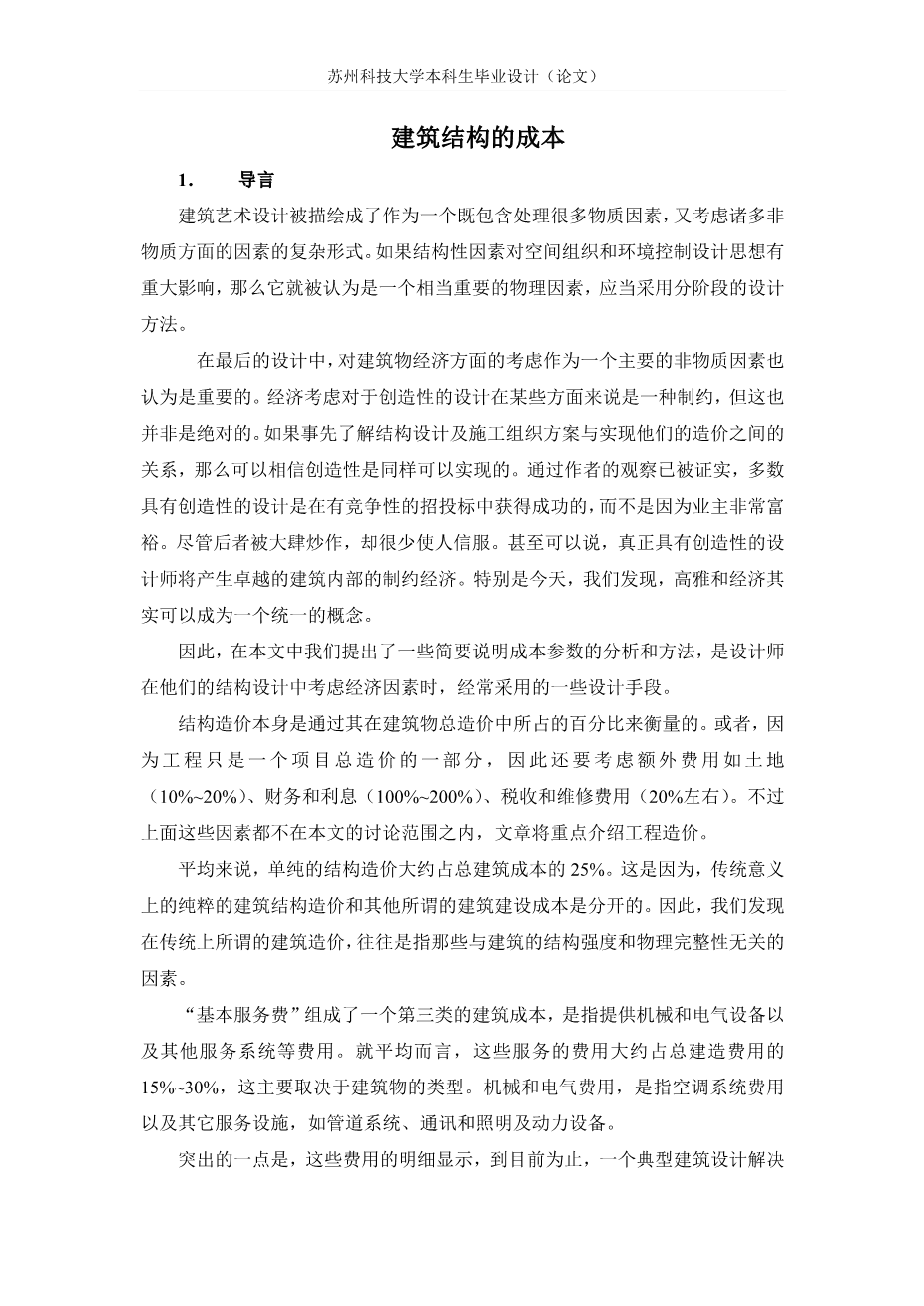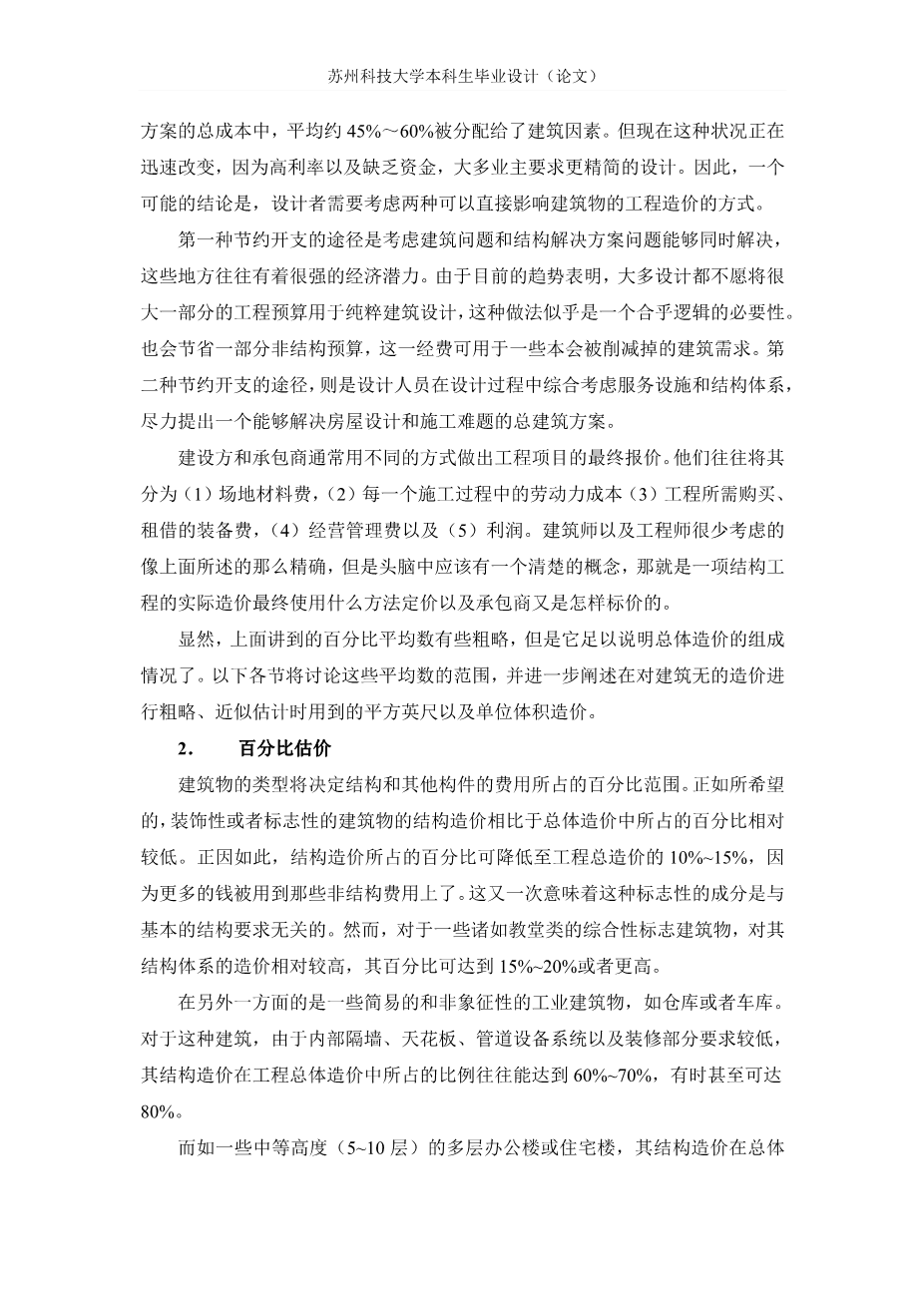Unit Eight The Cost of Building Structure
1. Introduction
The art of architectural design was characterized as one of dealing comprehensively with a complex set of physical and nonphysical design determinants. Structural considerations were cast as important physical determinants that should be dealt with in a hierarchical fashion if they are to have a significant impact on spatial organization and environmental control design thinking.
The economical aspect of building represents a nonphysical structural consideration that, in final analysis, must also be considered important. Cost considerations are in certain ways a constraint to creative design. But this need not be so. If something is known of the relationship between structural and constructive design options and their cost of implementation, it is reasonable to believe that creativity can be enhanced. This has been confirmed by the authorsrsquo; observation that most enhanced. This has been confirmed by the authorsrsquo; observation that most creative design innovations succeed under competitive bidding and not because of unusual owner affluence as the few publicized cases of extravagance might lead one to believe. One could even say that a designer who is truly creative will produce architectural excellence within the constraints of economy. Especially today, we find that there is a need to recognize that elegance and economy can become synonymous concepts.
Therefore, in this chapter we will set forth a brief explanation of the parameters of cost analysis and the means by which designers may evaluate the overall economic implications of their structural and architectural design thinking.
The cost of structure alone can be measured relative to the total cost of building construction. Or, since the total construction cost is but a part of a total project cost, one could include additional consideration for land(10~20percent),finance and interest(100~200 percent),taxes and maintenance costs (on the order of20 percent).But a discussion of these so-called architectural costs is beyond the scope of this book, and we will focus on the cost of construction only.
On the average, purely structural costs account for about 25 percent of total construction costs. This is so because it has been traditional to discriminate between purely structural and other so-called architectural costs of construction. Thus, in tradition we find that architectural costs have been taken to be those that are not necessary for the structural strength and physical integrity of a building design.
“Essential services” forms a third construction cost category and refers to the provision of mechanical and electrical equipment and other service systems. On the average, these service costs account for some 15 to 30 percent of the total construction cost, depending on the type of building. Mechanical and electrical refers to the cost of providing for air-conditioning equipment and he means on air distribution as well as other services, such as plumbing, communications, and electrical light and power.
The salient point is that this breakdown of costs suggests that, up to now, an average of about 45 to 60 percent of the total cost of constructing a typical design solution could be considered as architectural. But this picture is rapidly changing. With high interest costs and a scarcity of capital, client groups are demanding leaner designs. Therefore, one may conclude that there are two approaches the designer may take towards influencing the construction cost of building.
The first approach to cost efficiency is to consider that wherever architectural and structural solutions can be achieved simultaneously, a potential for economy is evident. Since current trends indicate a reluctance to allocate large portions of a construction budget to purely architectural costs, this approach seems a logical necessity. But, even where money is available, any use of structure to play a basic architectural role will allow the nonstructural budget to be applied to fulfill other architectural needs that might normally have to be applied to fulfill other architectural needs that might normally have to be cut back. The second approach achieves economy through an integration of service and structural subsystems to round out onersquo;s effort to produce a total architectural solution to a building design problem.
The final pricing of a project by the constructor or contractor usually takes a different form. The costs are broken down into (1) cost of materials brought to the site, (2)cost of labor involved in every phase of the construction process, (3)cost of equipment purchased or rented for the project, (4)cost of management and overhead, and(5) profit. The architect or engineer seldom follows such an accurate path but should perhaps keep in mind how the actual cost of a structure is finally priced and made up.
Thus, the percent averages stated above are obviously crude, but they can suffice to introduce the nature of the cost picture. The following sections will discuss the range of these averages and then proceed to a discussion of square footage costs and volume-based estimates for use in rough approximation of the cost of building a structural system.
2. Percentage Estimates
The type of building project may indicate the range of percentages that can be allocated to structural and other costs. As might be expected, highly decorative or symbolic buildings would normally demand the lowest percentage of structural costs as compared to total construction cost. In this case the structural costs might drop to 10~15percent of the total building cost because more money is allocated to the so-called architectural costs. Once again this implies that the symbolic components are conceived independent of basic structural requirements. However, where structure and symbolism are more-or-less synt
剩余内容已隐藏,支付完成后下载完整资料
英语译文共 7 页,剩余内容已隐藏,支付完成后下载完整资料
资料编号:[603575],资料为PDF文档或Word文档,PDF文档可免费转换为Word
课题毕业论文、外文翻译、任务书、文献综述、开题报告、程序设计、图纸设计等资料可联系客服协助查找。




